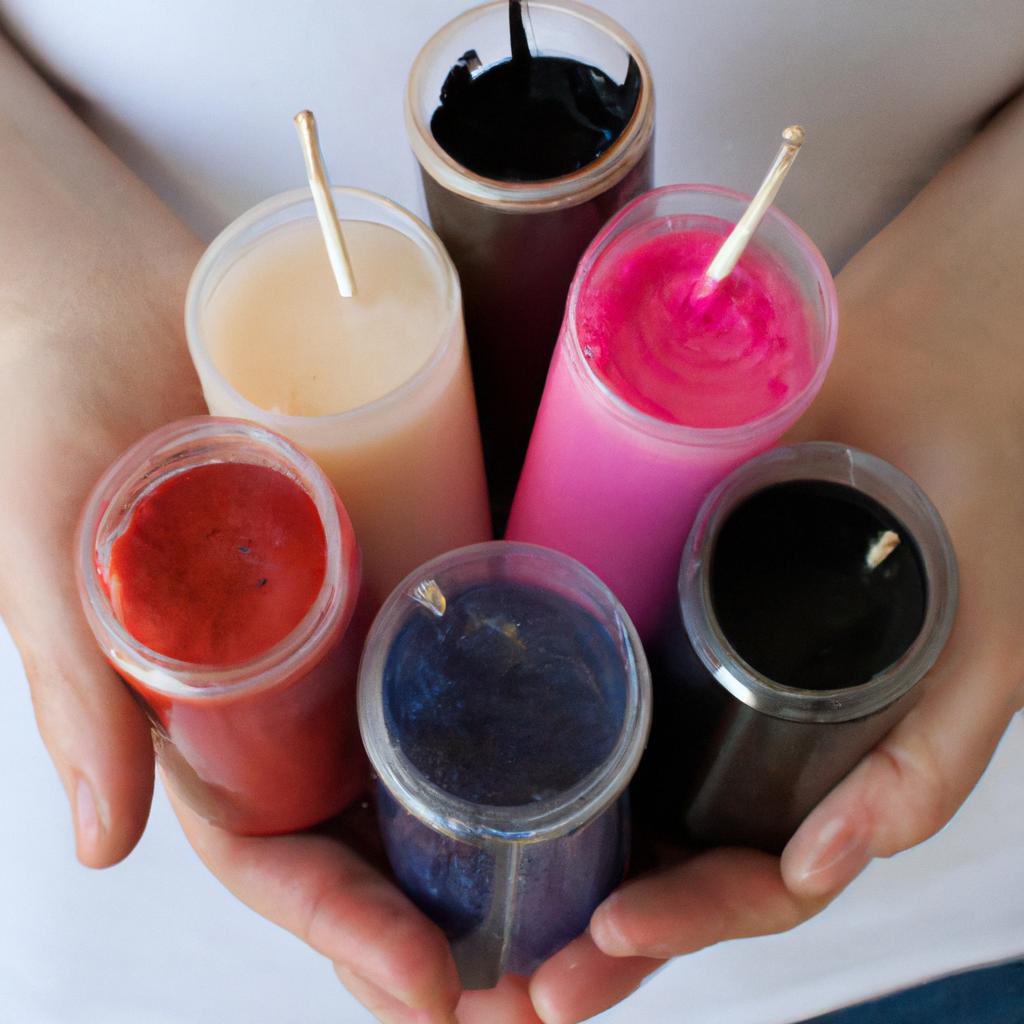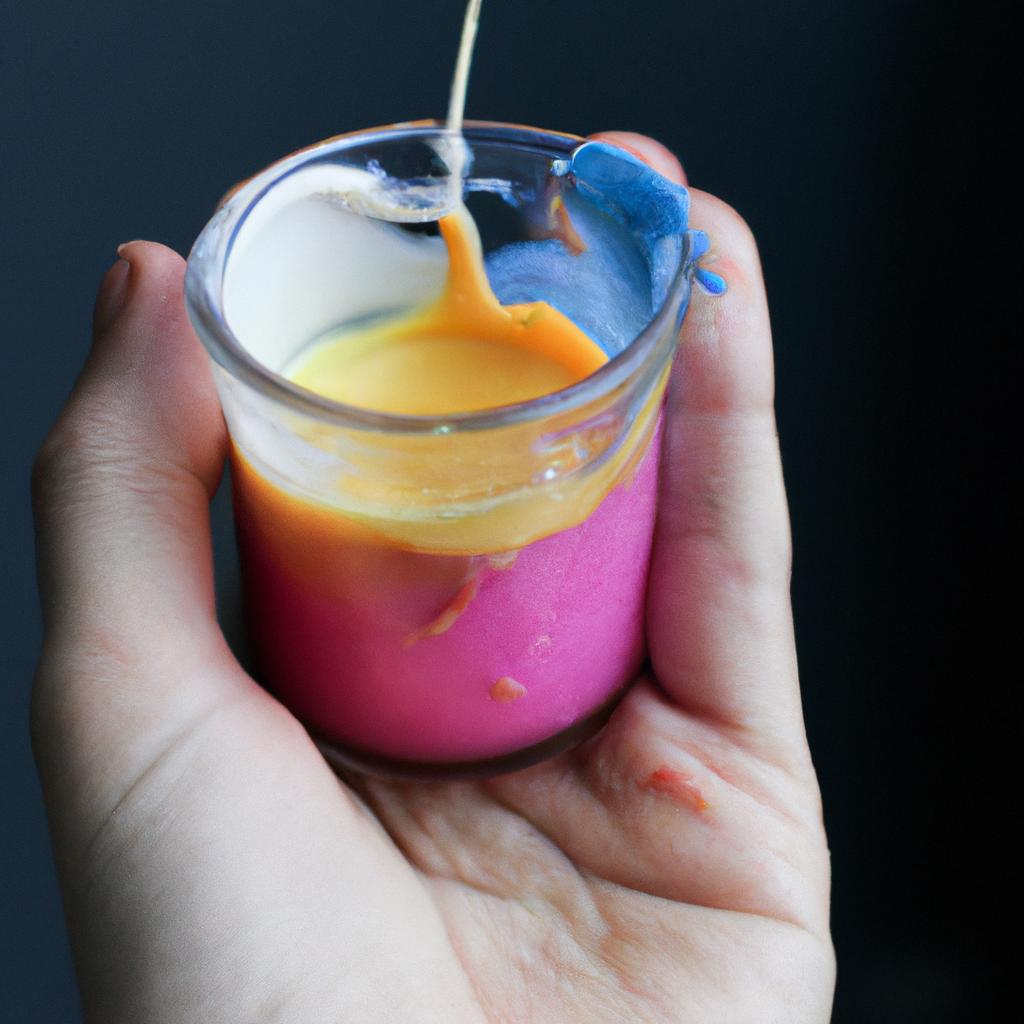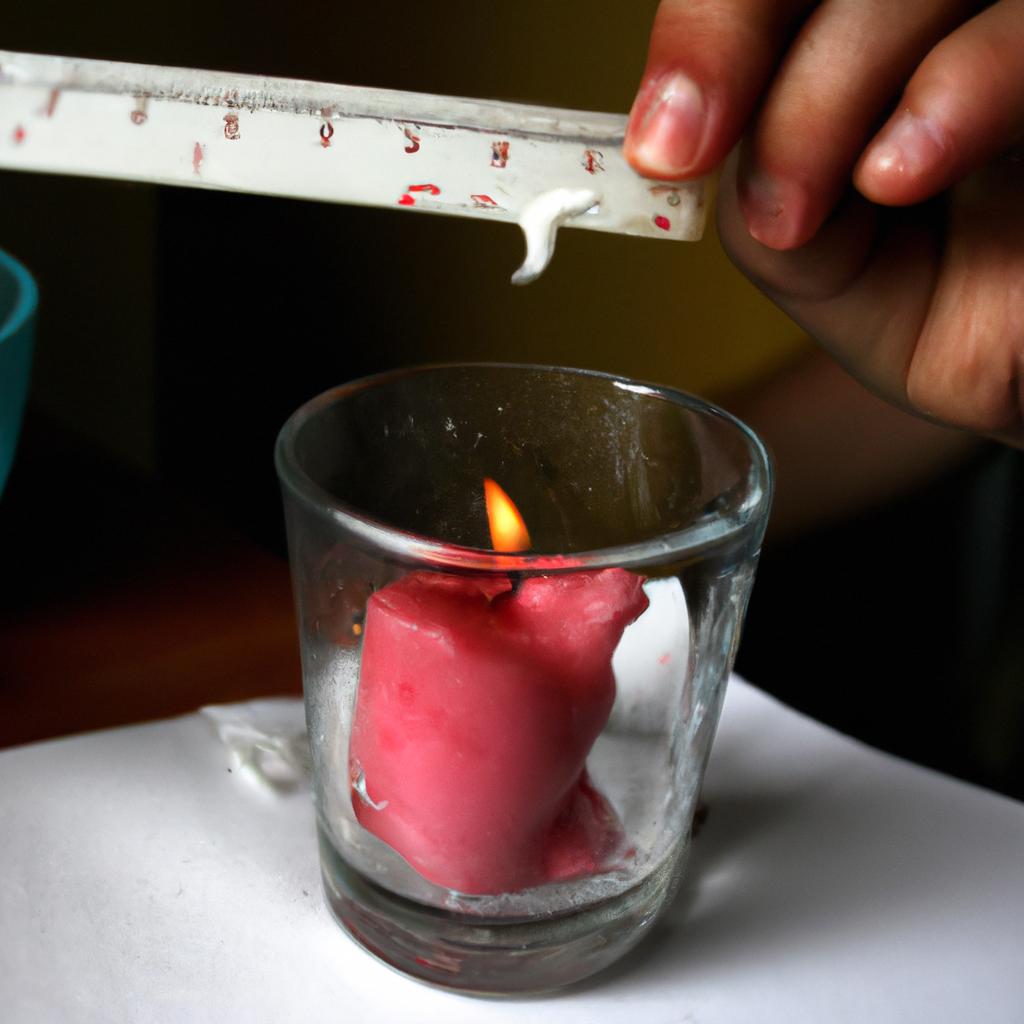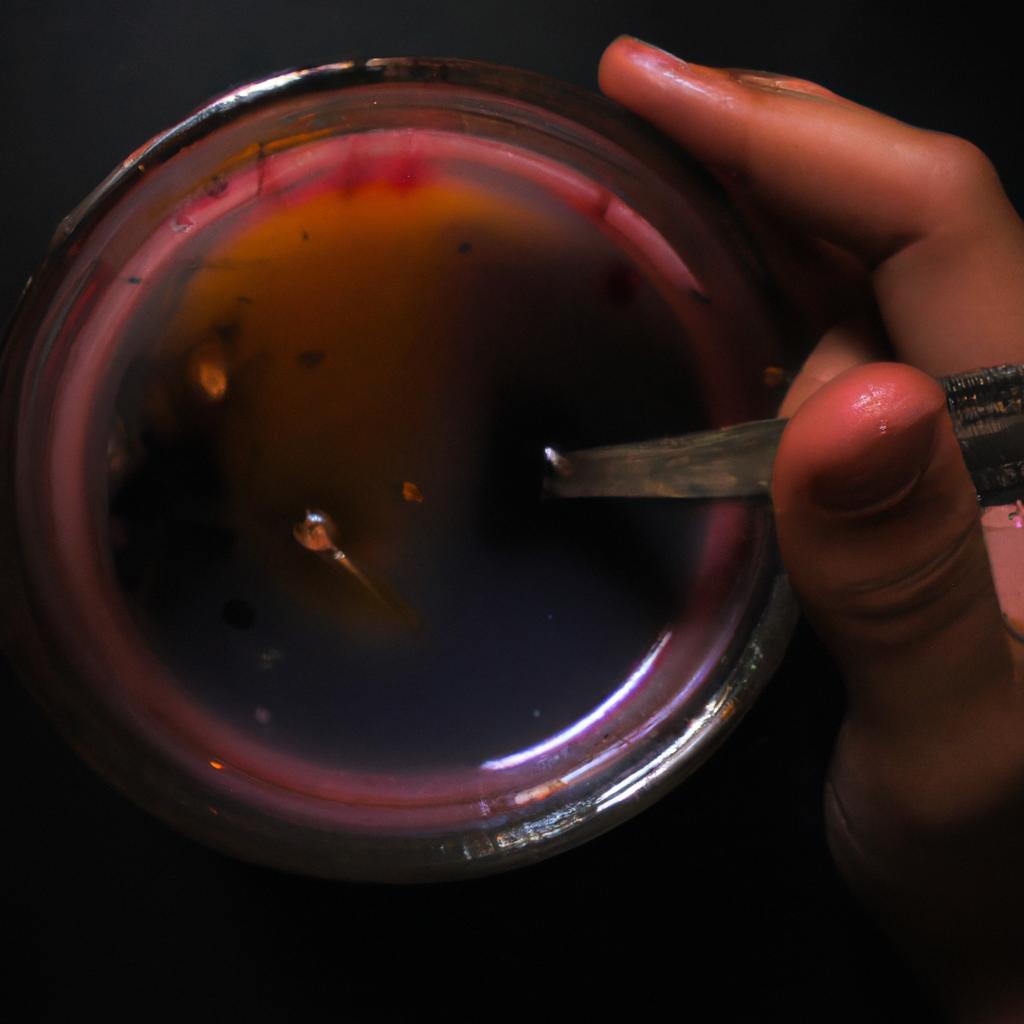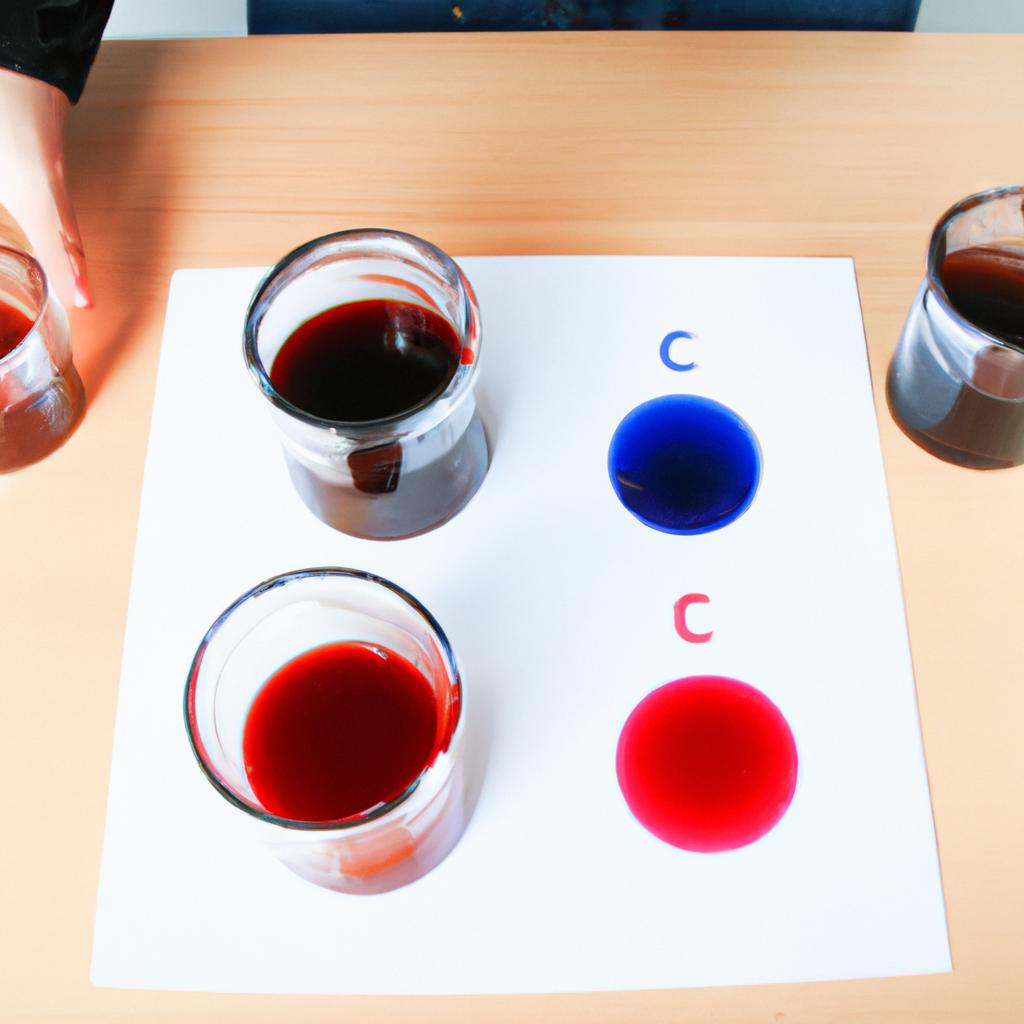Color Mixing Techniques in Candle Making: Candle Dye Usage

Color mixing techniques play a crucial role in the art of candle making, as they allow artisans to create captivating and visually appealing candles. By combining various dyes, crafters can achieve an array of vibrant hues that enhance the overall aesthetic appeal of their creations. For instance, imagine a scenario where a candle maker wishes to produce a batch of red candles for Valentine’s Day. Through skillful color mixing techniques, they can blend different shades of red dye to create unique variations and gradients, resulting in a collection of eye-catching and romantic candles.
In the realm of candle making, understanding the proper usage of candle dyes is essential for achieving desired color outcomes. Candle dyes are specially formulated pigments designed to be compatible with wax materials, allowing them to disperse evenly throughout the melted wax during the manufacturing process. This ensures consistent coloring throughout the entire candle body when solidified. Moreover, candle dyes possess varying solubility properties depending on factors such as temperature and wax type, which affects how effectively they mix and distribute within the wax medium. Therefore, mastering color mixing techniques involves not only selecting appropriate dyes but also considering their compatibility with specific waxes to ensure optimal results.
Choosing the Right Candle Wax
In candle making, selecting the appropriate candle wax is crucial for achieving desired results. For instance, let us consider a hypothetical scenario where an individual wishes to create vibrant and long-lasting colored candles. The choice of wax will greatly impact the outcome in terms of color intensity, burning time, and overall quality.
When it comes to selecting the right candle wax, several factors need consideration:
- Melting Point: Different waxes have varying melting points, which affects how quickly or slowly the candle burns. Consider opting for a wax with a higher melting point if you desire longer burn times.
- Fragrance Compatibility: Some waxes are better suited for holding fragrance oils than others. It is important to choose a wax that can retain scents effectively without compromising its structural integrity.
- Pouring Temperature: Certain waxes require specific pouring temperatures to achieve optimal results. Failure to adhere to these guidelines may result in poor adhesion between layers or uneven distribution of colorants.
- Additive Compatibility: If you plan on incorporating additives such as dyes or essential oils into your candles, ensure that your chosen wax is compatible with them to avoid any undesirable reactions.
To further illustrate the significance of choosing the right candle wax, refer to the table below highlighting different types of waxes commonly used in candle making:
| Type of Wax | Characteristics | Best Suited For |
|---|---|---|
| Paraffin | Affordable and versatile | Basic candles |
| Soy | Natural and eco-friendly | Aromatherapy candles |
| Beeswax | Long-burning and emits a pleasant natural scent | Decorative pillar candles |
| Palm | Renewable resource with good scent retention capabilities | Container jar candles |
Given these considerations, it becomes evident that selecting an appropriate candle wax sets the foundation for successful candle-making endeavors. Understanding how different waxes behave and their specific characteristics allows crafters to create candles that meet their desired color intensity, burn time, and overall quality. With this understanding established, let us now delve into the concept of primary colors in candle making.
(Note: Transition sentence) By comprehending the role of primary colors, one can effectively mix dyes to achieve a wide spectrum of hues for captivating candle designs.
Understanding Primary Colors
Color Mixing Techniques in Candle Making: Candle Dye Usage
Choosing the Right Candle Wax is an essential step in candle making, as it determines the overall quality and performance of the final product. Now, let’s delve into another important aspect of candle making: understanding primary colors and how they can be mixed to create beautiful and vibrant candles.
Imagine you are creating a batch of scented candles for a wedding celebration. The couple has requested pastel-colored candles that match their theme perfectly. To achieve this, you will need to mix different candle dyes to create custom shades that complement each other harmoniously.
When it comes to color mixing techniques in candle making, there are several approaches you can take:
-
Gradual Layering: This technique involves pouring layers of differently colored wax one on top of another. As the layered wax cools and solidifies, the different hues blend together beautifully, creating unique gradient effects.
-
Marbling Effect: By gently swirling two or more differently colored waxes together before pouring them into molds, you can achieve a marbled effect in your candles. This technique creates mesmerizing patterns with distinct swirls of contrasting colors.
-
Dip-Dye Technique: Similar to dip-dyeing fabric, this method involves partially immersing already formed candles into melted colored wax. As the dipped portion cools down and hardens, it acquires a new shade while still retaining its original color at the base.
To illustrate the process further, consider the following table showcasing some common primary colors and their possible combinations:
| Primary Color | Combinations |
|---|---|
| Red | Red + Yellow = Orange |
| Blue | Blue + Yellow = Green |
| Yellow | Yellow + Blue = Green |
| Yellow + Red = Orange |
By employing these color mixing techniques and experimenting with various combinations, you can unleash your creativity and bring to life candles that are not only visually appealing but also perfectly suited to your specific needs.
As we have explored the intricacies of primary color mixing, it is time to move on and discover the art of blending secondary colors. This next section will delve into how you can create an even wider range of hues by combining these already mixed shades. So, let’s embark on this colorful journey together!
[Blending Secondary Colors]
Blending Secondary Colors
Understanding Primary Colors
Color Mixing Techniques in Candle Making: Candle Dye Usage
Building upon the understanding of primary colors, let us now explore how these colors can be blended together to create secondary colors. This knowledge is essential for candle makers who wish to achieve a wide range of hues and shades in their creations.
Blending Secondary Colors:
To illustrate this process, consider the following example: Imagine you have two candles, one red and one yellow. By melting both candles separately and combining their liquid wax, you can create a new color by blending the red and yellow dyes together. In this case, mixing equal parts of red and yellow will result in an orange hue.
When it comes to blending secondary colors, there are several techniques that candle makers employ:
-
Gradual Blending: This technique involves gradually adding small amounts of one color dye into another while stirring continuously. It allows for precise control over the intensity and saturation of the resulting shade.
-
Layering Technique: The layering technique involves pouring multiple layers of different colored waxes into a single container or mold. Each layer is allowed to cool before the next one is added, creating distinct bands of colors within the final candle.
-
Marbling Effect: To achieve a marbled effect, different colored waxes are poured simultaneously into the container or mold without stirring them together completely. As they cool and solidify, swirls and patterns form naturally, resulting in unique combinations of colors throughout the candle.
-
Dip-Dyeing Method: Using this method, candlemakers dip pre-made candles into containers filled with colored wax at varying depths. This creates gradient effects as the dye adheres more strongly to certain areas due to longer immersion times.
| Color Combination | Emotional Response |
|---|---|
| Red + Yellow | Warmth |
| Blue + Green | Serenity |
| Purple + Orange | Creativity |
| Pink + Turquoise | Playfulness |
By employing these blending techniques, candle makers can evoke a range of emotional responses in their audience.
[Experimenting with Tertiary Colors]
Experimenting with Tertiary Colors
In the previous section, we explored the process of creating primary colors and their combinations to form secondary colors. Now, let’s delve into the art of blending these secondary colors in candle making to produce unique and captivating hues. To illustrate this concept, consider a scenario where you desire to create an orange-colored candle that exudes warmth and vibrancy.
To achieve this desired shade, it is important to understand how different ratios of secondary colors can be mixed together. Here are some key techniques for blending secondary colors effectively:
-
Gradual Addition: Start with equal parts of red and yellow dye chips or liquid dyes in your melted wax mixture. Slowly add more yellow as you stir until the desired shade of orange is achieved. This gradual addition allows for better control over color intensity.
-
Color Wheel Combinations: Referencing a color wheel can provide guidance on complementary blends for secondary colors. In our case study, adding a touch of blue dye can help balance the warmth of orange, resulting in a harmonious blend reminiscent of autumn sunsets.
-
Layering Technique: Another approach involves pouring layers of two different colored waxes into the mold simultaneously. For example, pour one layer using red-dyed wax followed by another layer using yellow-dyed wax. As both layers cool and solidify together, they will seamlessly merge into a beautifully blended orange hue.
-
Experimentation: Don’t be afraid to experiment with different ratios and shades until you find the perfect combination that matches your vision! Keep records of each attempt so you can learn from them and refine your technique further.
Creating unique color blends through careful manipulation is an exciting aspect of candle making that adds depth and character to your creations.
Next Section – Creating Gradient Effects
Creating Gradient Effects
To further expand our exploration of color mixing techniques in candle making, let us now delve into the fascinating realm of tertiary colors. Tertiary colors are created by blending primary and secondary colors together, resulting in hues that offer a wide range of possibilities for candle dye usage.
Imagine you have mixed equal parts red and orange dyes to create a beautiful shade called ‘Tangerine Burst’. By introducing this vibrant tertiary color into your candles, you can achieve an eye-catching effect that will surely captivate anyone who beholds it. The versatility of tertiary colors allows artisans to experiment and create unique combinations that resonate with their artistic vision.
When working with tertiary colors in candle making, consider the following tips:
- Begin by using small amounts of dye and gradually increase the intensity until you achieve the desired shade.
- Keep a record of the exact measurements used when creating each specific hue, as this will help replicate successful results in future batches.
- Experiment with different ratios of primary and secondary colors to discover new and exciting tertiary shades.
- Take note of how these tertiary hues interact with various wax types, as some waxes may result in slightly altered final colors.
Incorporating these tips while exploring tertiary colors opens up endless opportunities for creativity in candle making. To illustrate this point, refer to Table 1 below which showcases four examples of stunning tertiary color combinations achieved through experimentation:
| Primary Color | Secondary Color | Resulting Tertiary Color |
|---|---|---|
| Red | Orange | Tangerine Burst |
| Blue | Green | Teal Waters |
| Yellow | Purple | Amethyst Gold |
| Magenta | Cyan | Raspberry Sky |
Table 1: Examples of captivating tertiary color combinations
By embracing the magic of tertiary colors and utilizing them strategically in candle making, artisans can elevate their creations to new heights.
Transitioning into the subsequent section on “Tips for Achieving Vibrant Colors,” let us now uncover some valuable insights that will help you infuse your candle creations with a vivid and visually striking allure.
Tips for Achieving Vibrant Colors
Building upon the knowledge of creating gradient effects, this section delves into tips and techniques to achieve vibrant colors when using candle dyes. By incorporating these strategies, candle makers can elevate their creations and captivate customers with visually stunning candles.
To illustrate the impact of color mixing techniques, let’s consider a hypothetical scenario where a candle maker aims to create a vibrant red shade. Initially, they blend equal amounts of red and yellow dye into melted wax. However, instead of achieving the desired rich red hue, they end up with an orange-toned result. This outcome highlights the importance of understanding how different hues interact during the color-mixing process.
When aiming for vibrant colors in candle making, consider the following tips:
-
Start with high-quality dyes:
- Opt for professional-grade dyes that are specifically formulated for use in candles.
- Ensure that the chosen dyes are highly concentrated to produce vivid and long-lasting colors.
- Conduct thorough research or seek recommendations from experienced candle makers regarding reputable brands.
-
Experiment with dye ratios:
- Begin by testing small batches using varying proportions of primary colors (red, blue, and yellow) to determine optimal combinations.
- Keep detailed records of each experiment, noting down precise measurements and observations about resulting shades.
- Use these records as references to replicate successful mixes or make adjustments accordingly.
-
Utilize complementary colors:
- Complementary colors lie opposite each other on the color wheel (e.g., red-green or blue-orange).
- Incorporating small amounts of a complementary color into your mix can intensify vibrancy while maintaining balance.
-
Consider temperature variations:
- Temperature can affect the final color intensity of a candle.
- Experiment with different pouring temperatures and observe how they impact the overall hue.
- Keep in mind that certain dyes may require specific temperature ranges for optimal results.
By applying these tips, candle makers can unlock an extensive palette of vibrant colors. The table below showcases examples of complementary color combinations to inspire experimentation:
| Color Combination | Complementary Colors |
|---|---|
| Red + Green | Blue + Orange |
| Yellow + Purple | Pink + Teal |
| Orange + Blue | Red + Green |
| Violet + Yellow-Green | Indigo + Gold |
Remember, achieving vibrant colors requires patience and experimentation. Through meticulous testing and observation, candle makers can master the art of color mixing and create captivating candles that appeal to customers’ visual senses.
(Note: In conclusion or Finally)

